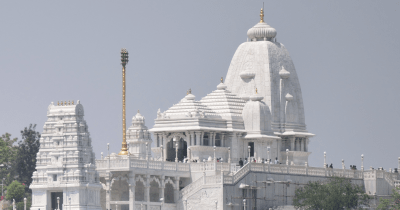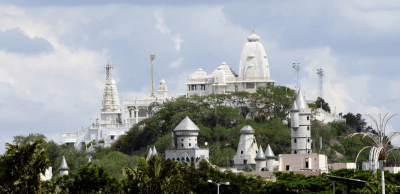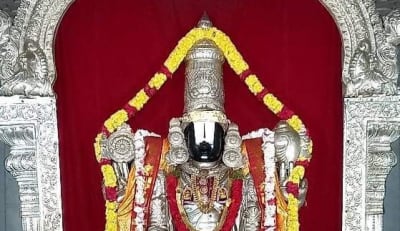The Hidden Beauty of Birla Mandir in Hyderabad You Must See

The Birla Mandir is a solid example of architecture, standing tall like a crown jewel above the city of Hyderabad. It is a place that shows how you can be enchanted by something and remain suspended in the air by the hustle and bustle of the city below, it is a spirit-nourishing place par excellence.
This is a temple that transcends boundaries--of time, geography and tradition. Composed in the 1970s by the Birla Foundation, the Mandir combines both North and South Indian forms of architecture, sheltering gods of all the branches of Hinduism, even Buddha. It does not present such a demand as belief; it encourages you to reflect. The Birla Mandir is, to a great extent, a monument to nothing; rather, it is an immobile meditation of sorts which you cannot help but meditate upon.
Let's know more about the journey of Birla Mandir; its thoughtful creation to its present place as a 21st-century spiritual —
A Temple of Maharajas, Built for Devotion and Meditation

The conception and financing of the temple was by the Birla Foundation a private charitable organization, which became a reality in the early 1970s. It was started around 1970 and with a decade of deductive workmanship, in 1976, the majestic structure was inaugurated by Swami Ranganathananda of the Ramakrishna Mission. It was not a haste structure; it was a consciously thought-out area.
Surprisingly, Swami Ranganathananda would not allow bells even to be there so an atmosphere of calm contemplation is created devoid of the usual noise in the temple. Rather it is the devotional songs of Tyagaraja, Annamayya and Ramadas in the soulful mantra in the early morning, that reverberate along the skyline of the city in the early morning.
White Marble: A Beacon Above the City

The first thing that a viewer sees is the spotless white profile of Birla Mandir. It used about 2,000 tonnes of marble quarried in Rajasthan which was carved out of Rajasthan to form its dazzling domes, pillars and walls. During the day the rays of the sun make it glossy; it becomes a shining jewel at twilight due to smart lightening that makes it guard the ever-changing face of Hyderabad.
Architectural Harmony: Where North Meets South

This Birla Mandir in Hyderabad is a beautiful cauldron of the architectural styles where North meets South —
-
Rajagopuram (i. e. main entrance tower): carries the grandeur of South Indian temples.
-
Jagadananda Vimanam (tower above the sanctum sanctorum): refers to architecture at Utkala (Odisha)
-
The interiors also have carvings of the Ramayana and Mahabharata with a sense of the artistic execution of the Rajasthan style of art.
The result? A temple, neither wholly southern nor wholly northern, but intertwined and beautiful and uniquely Hyderabadian, a city of fusion of different cultural influences.
A Deity Inspired by Tirupati

The central point of the sanctum is the 11-foot granite image of Lord Venkateswara, which is an object of inspiration based on the sacred Balaji of Tirupati. This majestic figure is adorned by the carved umbrella that represents a lotus, and that makes this figure look very powerful and at the same time calm.
The main idol is surrounded by independent temples of Padmavati and Andal, minor temples of Shiva, Shakti, Ganesh, Hanuman, Brahma, Saraswati, Lakshmi, Sai Baba and even Buddha, frescoed with calm images.
A Panorama of Hyderabad at Your Feet
The wrapping of the South East hillock with the soft curves of the landscape is captured in a 360-degree bird's eye view of Hyderabad and Secunderabad:
One of the most famous bodies of water is the Hussain Sagar Lake which glows like a precious stone during the day and at night.
Snippets of Lumbini Park, multiplex of Prasad and some distant urban views.
With the burning sunset, the temple appears to be hanging over an ocean of urban lights - a dream of the photographer and heaven of the devotees.
Nights Under the Stars
When the night falls, Birla Mandir is shown amazingly lit up, glimmering as a lantern on the hill of Kala Pahad. It is also common to find visitors organizing their visiting trips during the evenings-not only to have the spiritual ambiance, but also to enjoy the twinkling view of the city as far as their eye can see. Festivities, Flow, and Harmony Spreads across the streets are festivals such as Brahmotsavam, Diwali, Vaikunta Ekadashi, Navratri and Yellamma Kalyanotsavam (wedding of Goddess Yellamma) which are attended in multitude, predominantly during Navratri and Dussehra-it turns out to be a cloth of faith, illumination and music.
However, it is due to such occasions that the policy of no cameras or mobiles in the temple even keeps the sanctity intact.
A Visit That Nurtures the Soul
This is what it is like: the dawn comes, you crawl up the stone steps, mantras are ringing in the air, and Hyderabad wakes up down in the golden light. Or come on at sunset--warm colors swirled over the temple and mixed into the city skyline jostling with stars winking lights.
This is not architecture or ritual, this is a multisensory contemplation. It is that of stopping, breathing, and viewing the city from a sacred point of view being imbedded and disembodied.
Conclusion
Birla Mandir is not just a temple, but it is a place combining art, architecture, devotion and peace, and this temple is a historic monument in Hyderabad city. Be you pilgrim, lover of fine work, or tourist in pursuit of views, this temple does it welcomes thee with peaceful dignity and silent majesty.
With the riot of movement and sound that a city sometimes produces, Birla Mandir is a break, where a pause in time can be felt, where hearts open and where silence can speak. It keeps us reminded that devotion does not always require noise, that beauty can be great and tender, and that certain places are created not only to be seen but to be touched.




